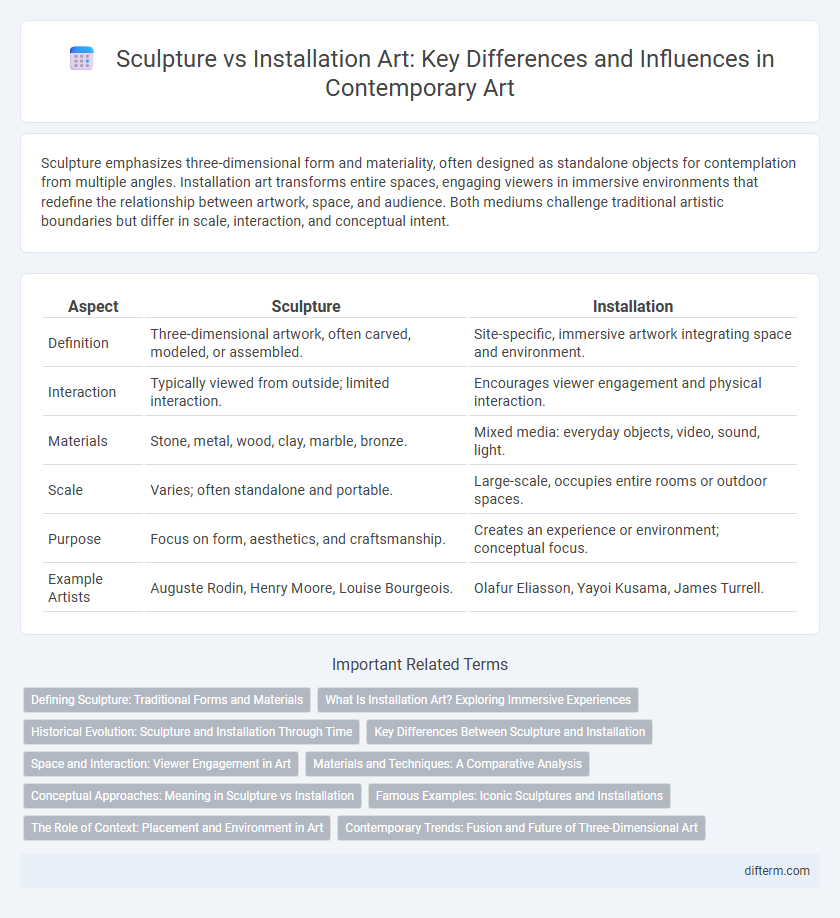Sculpture emphasizes three-dimensional form and materiality, often designed as standalone objects for contemplation from multiple angles. Installation art transforms entire spaces, engaging viewers in immersive environments that redefine the relationship between artwork, space, and audience. Both mediums challenge traditional artistic boundaries but differ in scale, interaction, and conceptual intent.
Table of Comparison
| Aspect | Sculpture | Installation |
|---|---|---|
| Definition | Three-dimensional artwork, often carved, modeled, or assembled. | Site-specific, immersive artwork integrating space and environment. |
| Interaction | Typically viewed from outside; limited interaction. | Encourages viewer engagement and physical interaction. |
| Materials | Stone, metal, wood, clay, marble, bronze. | Mixed media: everyday objects, video, sound, light. |
| Scale | Varies; often standalone and portable. | Large-scale, occupies entire rooms or outdoor spaces. |
| Purpose | Focus on form, aesthetics, and craftsmanship. | Creates an experience or environment; conceptual focus. |
| Example Artists | Auguste Rodin, Henry Moore, Louise Bourgeois. | Olafur Eliasson, Yayoi Kusama, James Turrell. |
Defining Sculpture: Traditional Forms and Materials
Sculpture traditionally involves three-dimensional artworks created from materials such as stone, metal, clay, or wood, often carved, modeled, or assembled to form enduring physical objects. These works emphasize volume, mass, and tactile qualities, embodying classical techniques rooted in historical art practices. Unlike installation art, which prioritizes spatial experience and conceptual interaction, sculpture maintains a focus on materiality and form as central elements of artistic expression.
What Is Installation Art? Exploring Immersive Experiences
Installation art transforms space by engaging viewers in immersive environments that blend sculpture, sound, light, and multimedia elements. Unlike traditional sculpture, which often emphasizes form and material, installation art prioritizes sensory experience and interaction within a specific site. This art form challenges perception by creating dynamic, enveloping settings that invite exploration and emotional response.
Historical Evolution: Sculpture and Installation Through Time
Sculpture, rooted in ancient civilizations, evolved from classical stone and bronze forms to modern abstract creations, reflecting cultural and technological shifts over millennia. Installation art emerged in the 20th century as a dynamic, immersive medium, challenging traditional sculpture by incorporating spatial experience and multidisciplinary materials. Both art forms reveal changing artistic priorities: sculpture's emphasis on form and permanence contrasts installation's focus on environment and temporality.
Key Differences Between Sculpture and Installation
Sculpture is a three-dimensional art form typically created from durable materials such as stone, metal, or wood, designed to occupy a specific space. Installation art transforms entire environments by integrating multiple elements, often incorporating sound, light, and interactive components to engage viewers spatially and temporally. While sculptures emphasize form and volume, installations prioritize immersive experience and conceptual interaction within a curated space.
Space and Interaction: Viewer Engagement in Art
Sculptures occupy space through three-dimensional forms that invite viewers to navigate around and physically connect with the artwork's tangible presence. Installations transform entire environments, enveloping audiences and fostering immersive, multisensory experiences that challenge traditional spatial boundaries. Interaction in sculpture emphasizes tactile engagement and spatial awareness, while installations prioritize dynamic viewer participation and the modulation of perception within a curated space.
Materials and Techniques: A Comparative Analysis
Sculptures traditionally utilize materials such as stone, metal, and wood, crafted through techniques like carving, casting, and welding, emphasizing form and durability. Installation art incorporates diverse and often unconventional materials including found objects, digital media, and light, using assemblage and interactive methods to create immersive spatial experiences. The contrast in material choice and construction techniques reflects sculpture's focus on physical presence versus installation's emphasis on environment and viewer interaction.
Conceptual Approaches: Meaning in Sculpture vs Installation
Sculpture traditionally emphasizes form, materiality, and spatial presence to convey meaning through physicality and craftsmanship. Installation art prioritizes immersive environments and viewer interaction, where meaning arises from the relationship between space, objects, and sensory experience. Conceptually, sculpture often embodies symbolic and aesthetic significance, while installation challenges perception, encouraging active interpretation and engagement.
Famous Examples: Iconic Sculptures and Installations
Michelangelo's "David" exemplifies iconic sculpture with its detailed marble craftsmanship and classical form, while Yayoi Kusama's "Infinity Mirror Rooms" revolutionize installation art through immersive, reflective environments. Sculptures like Rodin's "The Thinker" emphasize three-dimensional, standalone figures that capture human emotion, contrasting with installations such as Christo and Jeanne-Claude's "The Gates," which transform entire landscapes into temporary art experiences. These famous examples highlight the distinct experiential and spatial qualities defining sculpture and installation art.
The Role of Context: Placement and Environment in Art
Sculptures often emphasize form and materiality, inviting viewers to engage with physical space and texture. Installations transform entire environments, integrating architecture, light, sound, and viewer interaction to create immersive experiences. Context and placement are crucial in shaping the meaning and impact of both art forms, as they determine how audiences perceive and relate to the work within a given space.
Contemporary Trends: Fusion and Future of Three-Dimensional Art
Contemporary trends in three-dimensional art increasingly blur the boundaries between sculpture and installation, emphasizing immersive experiences and conceptual depth. Artists fuse traditional sculptural techniques with spatial interventions, integrating technology, light, and sound to create interactive environments that challenge conventional art consumption. This fusion heralds a future where three-dimensional art transcends physical form, engaging audiences in multi-sensory narratives and expanding the definition of space and object in art practice.
sculpture vs installation Infographic

 difterm.com
difterm.com